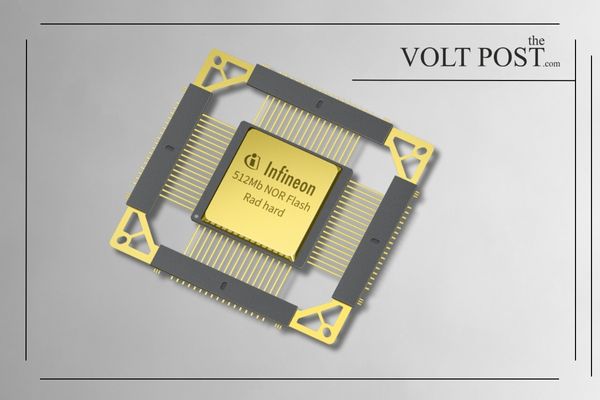The first radiation-hardened-by-design 512 Mbit QSPI NOR Flash memory for space and harsh environment applications was unveiled by Infineon Technologies. For usage with space-grade FPGAs and microprocessors, the new device is said to provide the best density, radiation, and single-event effects (SEE) performance in a fully QML-qualified non-volatile memory, together with a fast quad serial peripheral interface (133 MHz).
The new device, which was developed in collaboration with Microelectronics Research Development Corporation (Micro-RDC) and partially funded by the U.S. Air Force Research Laboratory, Space Vehicles Directorate (AFRL), is based on Infineon’s field-proven SONOS (Silicon-Oxide Nitride-Oxide-Silicon) charge gate trap technology and can operate up to 30% faster than lower density alternatives.
With exceptional endurance of up to 10,000 P/E and up to 10 years of data retention, Infineon’s SONOS technology provides an unparalleled radiation performance along with a unique density and speed combination.
For CPUs and space-grade FPGA, the 133 MHz QSPI interface offers quick data transmission rates. There is a ceramic QFP (QML-V) package that takes up 1″ x 1″ of board space, and there is also a plastic TQFP (QML-P) that is even smaller, measuring 0.5″ x 0.8″.
Furthermore, the QML-V/P with DLAM certification satisfies the most demanding industrial requirements, and the device provides the highest density TID/SEE performance combination for space FPGA boot code solutions.
Space-grade FPGA configuration image storage and space-grade multi-core CPU standalone boot code storage are two common applications for this device.
Infineon’s SONOS technology underlies a unique combination of density and speed, as well as unsurpassed radiation performance, with excellent endurance of up to 10,000 P/E and up to 10 years of data retention.
The 133 MHz QSPI interface provides fast data transfer rates for space-grade FPGA and processors. A ceramic QFP (QML-V) package occupies 1” x 1” board area, and an even smaller footprint plastic TQFP (QML-P) 0.5” x 0.8” is available.
Additionally, the device offers the highest density TID/SEE performance combination for space FPGA boot code solutions and the QML-V/P with DLAM certification meets the most stringent industry qualifications.
Key Comments
“Designers of next-generation space-grade systems continue to demand high-reliability, high-density memories. Working with such industry-leaders as Infineon and Micro-RDC led to a technology solution that combines high density and fast data rates with superior radiation performance compared to alternatives,” said Richard Marquez, AFRL Space Electronics Technology Program Manager.
“Infineon’s radiation-hardened-by-design NOR flash memory is an ideal complement to Micro-RDC’s family of solutions for extreme application environments,” said Joseph Cuchiaro, President, Micro-RDC. “With the availability of 512 Mbit density devices, designers will be able to implement systems with the performance to meet stringent requirements across a wider range of mission profiles than previously possible.”
“The extension of Infineon’s 512 Mbit NOR Flash memory to its rad-hard memory portfolio is further testament to our commitment to deliver highly reliable and high-performance memories for next-generation space requirements,” said Helmut Puchner, Vice President, Fellow, Aerospace and Defense, Infineon Technologies. “This collaborative effort with AFRL and Micro-RDC advances the industry state-of-the-art to address the extreme environments encountered in space applications with technology that will improve performance in critical satellite functions.”
A typical use case for this device includes configuration image storage for space-grade FPGAs and standalone boot code storage for space grade multi-core processors.
Availability
The new Infineon 512 Mbit QML-qualified NOR Flash is available now. For more information, visit Infineon’s 512 Mbit rad hard NOR Flash.




